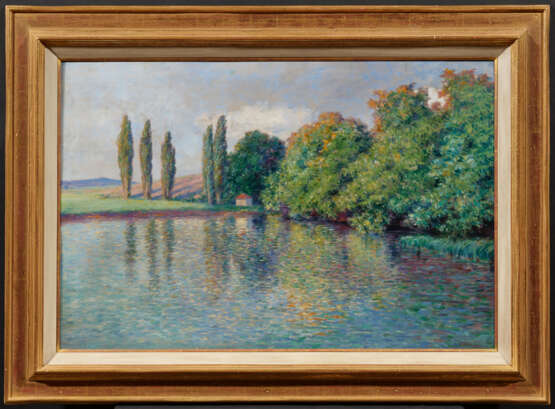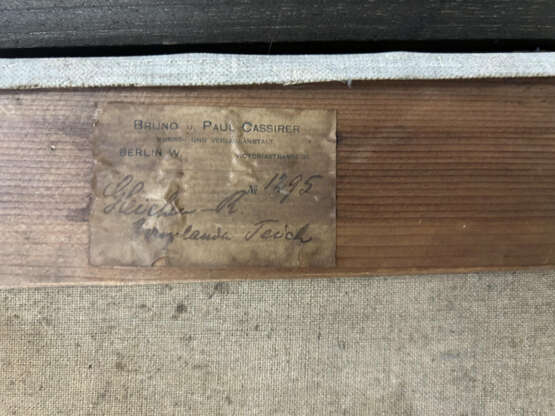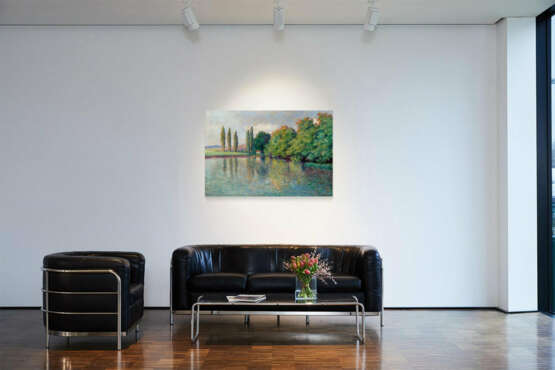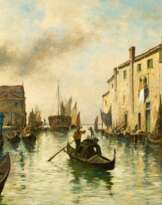ID 1424237
Lot 1360 | Bonnländer Teich
Valeur estimée
€ 12 000 – 15 000
Title: "Bonnländer Teich".
Date: 1899.
Technique: Oil on canvas.
Measurement: 86 x 128cm.
Notation: Signed and dated lower right: "Gleichen-Russwurm 99".
Frame: Framed.
When the sun is low, five poplars cast long blue shadows on the red-brown earth, while in the treetops of the deciduous trees, the last rays of sunlight bathe the leaves in a bright golden yellow. Nature is at the zenith of its growth and presents itself in lush green. The artist is equally interested in the depiction of the landscape and its reflection on the water, to which he devotes almost half of the canvas surface. In the reflection of the gently moving pond, he breaks down the forms of the surrounding vegetation and the cloudy sky almost pointillistically into their individual colours.
The artist Heinrich Ludwig von Gleichen-Rußwurm was fascinated by the closeness to nature and the emphasis on the moment as well as the sketch-like style of painting outdoors that emerged in the 19th century with French Impressionism. Born in Lower Franconia, the only grandson of Friedrich Schiller and godchild of King Ludwig I of Bavaria, he initially trained as a farmer in order to work as a landowner. After the early death of his young wife, he began training in landscape painting at the Grand Ducal Saxon School of Art in Weimar, where he was taught by Stanislaus von Kalckreuth and the artists Max Schmidt and Theodor Hagen, among others.
A decisive turning point in Gleichen-Rußwurm's artistic development was his trip to France in 1876, where he became acquainted with the Barbizon School, which is considered a forerunner of Impressionism with its focus on realistic depictions of nature.
Gleichen-Rußwurm preferred to paint landscapes and scenes of rural life, particularly in his home town of Weimar and when travelling, for example to the North Sea. He was known for painting his motifs directly on location in bright colours and preferred a coarse, impasto brushstroke, which characterises his late work in particular. The present important painting 'Bonnländer Teich' also belongs to this period. Like the painting 'Die Große Bleiche' (1889), which we were able to sell for an international record price in 2018, it is one of his major works and is probably the last large painting the artist created. A colour lithograph created around 1900 shows the same view of the pond (exhib. cat. 'Landschaft im Licht', 2010, p. 203, ill. 53), which is located in the immediate vicinity of Greifenstein Castle, the ancestral seat of the noble family on the edge of the village of Bonnland, where the artist grew up.
In 1900, the painting was presented at Bruno and Paul Cassirer in Berlin. In the exhibition, it hung alongside works by Claude Monet, Camille Pissarro, Alfred Sisley, Carl Strathmann and Max Liebermann, among others, which clearly placed it in the context of French painting. "Gleichen-Rußwurm's skill is most evident in the [...] 'Bonnländer Teich'", the contemporary press praised the work and its impressive mood of light.
Gleichen-Rußwurm was already considered an important representative of Impressionism in Germany during his lifetime, but was largely forgotten after his death. His work was only rediscovered after the Second World War and later, in particular through the 2010 exhibition 'German Impressionism' at the Kunsthalle Bielefeld, and his importance was recently confirmed by the 2021/22 retrospective 'Landscape in the Light' in Würzburg and Weimar. He was one of the first German artists to turn to Impressionism and played a key role in establishing this pioneering art movement in Germany.
| Artiste: | Heinrich Ludwig von Gleichen-Russwurm (1836 - 1901) |
|---|---|
| Technique appliquée: | Huile |
| Catégorie maison de vente aux enchères: | Peintures de maîtres récents |
| Artiste: | Heinrich Ludwig von Gleichen-Russwurm (1836 - 1901) |
|---|---|
| Technique appliquée: | Huile |
| Catégorie maison de vente aux enchères: | Peintures de maîtres récents |
| Adresse de l'enchère |
VAN HAM Kunstauktionen GmbH Hitzelerstr. 2 50968 Köln Allemagne | ||||||||||||||
|---|---|---|---|---|---|---|---|---|---|---|---|---|---|---|---|
| Aperçu | |||||||||||||||
| Téléphone | +49 221 92586215 | ||||||||||||||
| Fax | +49 221 92 58 62 4 | ||||||||||||||
| Commission | 32% | ||||||||||||||
| Conditions d'utilisation | Conditions d'utilisation | ||||||||||||||
| Heures d'ouverture | Heures d'ouverture
|









